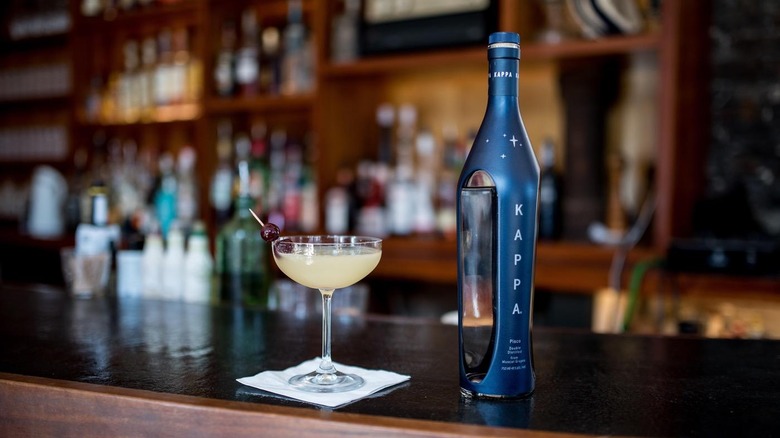What Is Pisco?
Pisco: It's here, it's clear and it's about to be everywhere. We've recently spotted this summery South American spirit creeping onto cocktail menus throughout the country, adding both complexity and gorgeous aromatics to a wide range of boozy libations.
RELATED Bringing Back the Art of Digestifs, One Amaro at a Time "
"Pisco became popular in the U.S. during the Gold Rush in San Francisco," explains Albert Somoza, the commercial director for Domaines Bournet-Lapostolle, one of Chile's leading producers of pisco. "There was no Panama Canal then, so ships sailed around South America, picking up cachaça, pisco and tequila on their way. But it wasn't until the more recent craft cocktail boom that pisco made a resurgence."
Sounds great, but what the heck is it? Here's a primer to get your engines started.
What's in Pisco?
Simply put, pisco is a type of brandy, or distilled grape wine. It's a clear(ish), higher-proof spirit, clocking in anywhere from 60 to 100 proof, and often features a fresh bouquet of aromatics and a touch of sweetness on the palate (though some piscos can taste more bitter or herbaceous). The grapes come from Chile or Peru, depending on the style, and each region maintains its own set of production regulations.
How Is Pisco Made?
Both Peruvian and Chilean pisco begin life as grape juice, which is first fermented into common wine. It's then run through a still to make liquor. And that's pretty much where the similarities between the two varieties end.
What's the Difference Between Peruvian and Chilean Pisco?
Peru's pisco is generally made up of either a single variety, classified as Puro pisco, or a blend of Quebranta, Mollar, Common Black, Muscat, Albilla, Italia and Torontel grapes. It's distilled in a copper pot still and can go through the process only once, resulting in an alcohol content between 38 and 48 percent. After its rested for a minimum of three months in either glass or metal containers, it's bottled solo (no additives or additional flavoring allowed), and, presto, we're in business. Peruvian law also requires that the spirit be made within one of the five official denomination of origin areas: Lima, Inca, Arequipa, Moquegua and Tacna.
Chilean pisco can be diluted, unlike Peruvian pisco. The Chileans can run the juice through a still however many times they please, which creates a more potent product each time, though the final spirit must be kept under 73 percent alcohol (hence the need for dilution). It's then aged for a minimum of 60 days, in either glass, metal, ceramic or wood containers. Bottles are labeled in terms of alcohol content, from 30 percent ABV (Pisco Corriente/Traditional) to 43 percent (Gran Pisco). Also, in Chile, it's mandated that each distillery must grow its own grapes, and the accepted varieties include Muscat, Torontel, Pedro Ximénez or Moscatel de Asturia.
Pisco Varieties to Know
Peru
Puro/Pure: This style is produced using just one grape variety, usually Quebranta.
Acholado: This blended spirit draws on several different kinds of grapes.
Mosto Verde: This one's made by distilling partially fermented grapes. The extra sugar lends itself to a more velvety final product.
Chile
Transparent/White: This guy's aged for 60 days, usually in glass, stainless steel or ceramic vessels, or untreated wood.
Envejecido/Aged: Instead of glass, metal or clay, this stuff spends a full year in French or American oak barrels, though some distillers keep it in there for two or more years.
De Guarda: Basically Envejecido's big brother, this spends at least 180 days in French or American oak.
How Do You Drink Pisco?
Odds are if you've seen pisco before it was in a pisco sour, both Peru's and Chile's national drink. The traditional Peruvian refresher is composed of pisco, tart Key limes, an egg white and Angostura bitters; shaken hard; and served chilled. The Chileans drop the egg white, opting for a combo of pisco, lemon juice, ginger and powdered sugar, shake and present cold.
If you're going to drink it straight, swing for an aged Chilean pisco. Because it's aged on wood, the flavors are more rounded, landing somewhere between a cognac and a delicate rum with a brighter, more citrusy nose.
"Aged pisco rested in active wood for at least a year is excellent as a digestif," Somoza recommends. "Guarda pisco especially, aged no less than 180 days in active wood barrels, showcases the fragrance and structure that the wood imparts."
Of course, bartenders love playing with the product. It can both elevate complex concoctions, and replace gin or vodka for a smoothing effect.
"I really like pisco with things that are bitter, like Suze or Campari. If the distillate is good, you can really taste a lot of new things in it, and it adds layers to cocktails. It's also a clear spirit, generally, so it's a good way to get people off the vodka soda train," says Ivy Mix, who, along with co-owner Julie Reiner, heads up Leyenda, one of NYC's top cocktail bars.
Any way you slice it, this Latin wonder is destined to be your new summertime go-to.





